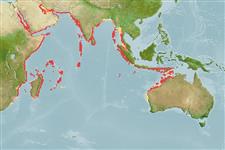Common names from other countries
>
Eupercaria/misc (Various families in series Eupercaria) >
Labridae (Wrasses) > Corinae
Etymology: Coris: Greek, kore, -es = pupil and also with themenaing of "maid" (Ref. 45335).
More on author: Bennett.
Environment: milieu / climate zone / depth range / distribution range
Ecologia
marino associati a barriera corallina; distribuzione batimetrica 2 - 50 m (Ref. 90102). Tropical; - 30°S
Indian Ocean: Red Sea and along the southern Arabian Peninsula south to Zanzibar and South Africa (30°S) and east to the Laccadive Archipelago, Chagos Archipelago, Maldives, Sri Lanka, and the Similan Islands, eastern Andaman Sea.
Size / Peso / Age
Maturity: Lm ? range ? - ? cm
Max length : 38.0 cm TL maschio/sesso non determinato; (Ref. 11441)
Inhabits exposed outer reef flats and lagoon and seaward reefs, in areas of mixed sand, coral and rubble (Ref. 9710). Juveniles occur in small tide pools, exposed reef flats with algae-rubble. Generally solitary (Ref. 5213). Feeds mainly on hard-shelled prey, including crustaceans, mollusks and sea urchins (Ref. 5374). Turns over rocks to prey on hiding invertebrates (Ref. 11441). Young look very different (Ref. 1623).
Life cycle and mating behavior
Maturities | Riproduzione | Spawnings | Egg(s) | Fecundities | Larve
Oviparous, with distinct pairing during breeding (Ref. 205).
Randall, J.E., 1999. Revision of the Indo-Pacific labrid fishes of the genus Coris, with descriptions of five new species. Indo-Pac. Fish. (29):74 p. (Ref. 33411)
IUCN Red List Status (Ref. 130435)
CITES (Ref. 128078)
Not Evaluated
Threat to humans
Harmless
Human uses
Pesca: scarso interesse commerciale
Strumenti
Special reports
Download XML
Fonti Internet
Estimates based on models
Preferred temperature (Ref.
115969): 25.3 - 29.3, mean 27.9 (based on 466 cells).
Phylogenetic diversity index (Ref.
82804): PD
50 = 0.5000 [Uniqueness, from 0.5 = low to 2.0 = high].
Bayesian length-weight: a=0.00977 (0.00470 - 0.02030), b=3.07 (2.89 - 3.25), in cm Total Length, based on LWR estimates for this (Sub)family-body shape (Ref.
93245).
Trophic level (Ref.
69278): 3.4 ±0.40 se; based on food items.
Resilienza (Ref.
120179): Medio, tempo minimo di raddoppiamento della popolazione 1.4 - 4.4 anni (Preliminary K or Fecundity.).
Fishing Vulnerability (Ref.
59153): Low to moderate vulnerability (28 of 100).
